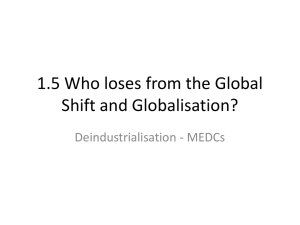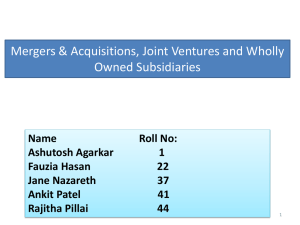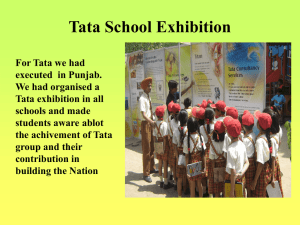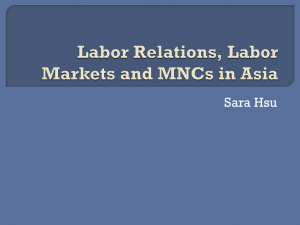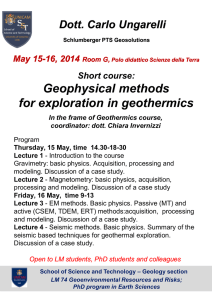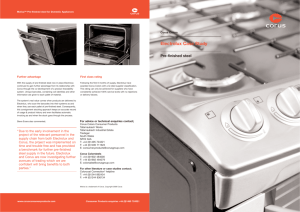View Presentations
advertisement
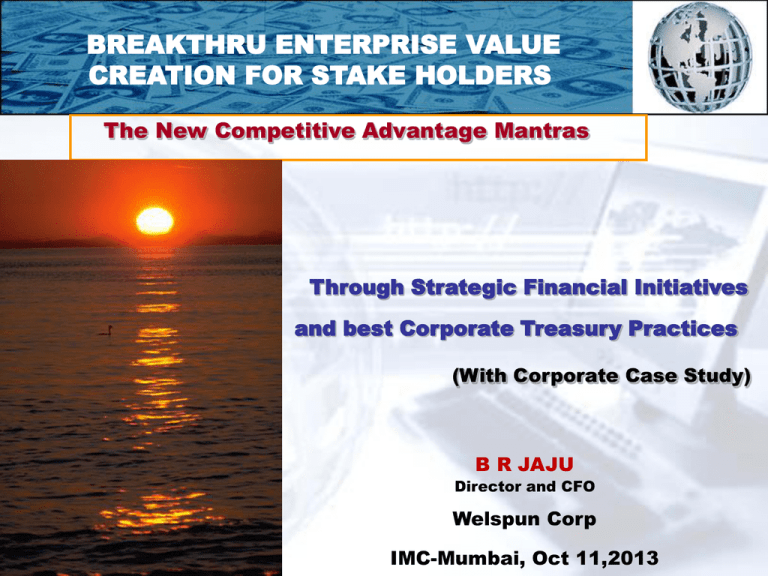
BREAKTHRU ENTERPRISE VALUE CREATION FOR STAKE HOLDERS The New Competitive Advantage Mantras Through Strategic Financial Initiatives and best Corporate Treasury Practices (With Corporate Case Study) B R JAJU Director and CFO Welspun Corp IMC-Mumbai, Oct 11,2013 Steroids Conventional Way of Managing Business /Finance + No Ethical practices & Growth Strategy + IT iIlusion = Dying Corporates on Steroids 4/13/2015 3 Let us take deep dive • Changing business landscaping : India perspective with global paradigms & New age CFO challanges • Value propositions : Enhance enterprise value and strategy map • Moving into new orbits : Preparing for renewed growth thru best financial practices • Business growth strategies : M&A and key concerns • Corporate Case Study : trigger for learnings • Parting thoughts and key take aways Changing business landscaping (India perspective with global paradigms) Global Dynamics –India’s perspective Prior to 1990s - India is the only market - The manufacturer could sell whatever it could produce 2005 - After 1990-2005 - Exposed to International Markets(Products &Capital) and Competition - Achieve viability of operations in global environment - Change in mindset to become a global company IT enabled Processes & Technology Advancement Changing Business Models (Consolidation & Outsourcing) Regulatory Compliances Global Competition Initiatives Initiatives Business Dynamics M&A Customer Expectation Governance & Best Practices Business Risks & Security Concerns How Global Corporates have destroyed values –Key learnings Self Denial Arrogance (Pride before fall) Complacency Greed Obsession Emerging Technologies Changing Customer Tastes Conflicting Interests/Frauds Exceptional Achieve of Past wraps present realities Nobody can duplicate your products You are smarter than others Past Success under regulated monopoly U were chosen for success by govt U are run with Govt. control Justify every financial norms for growth and unearned profits Achieve growth devoid of business fundamentals Overleveraging and over trading on equity Let us look at Corporate value destroyers Corporate Scandal Created off B/S exposures to hide debts & losses Enron Xerox Worldcom Merck Quest.com Jobs Lost 4500 Shareholders wealth lost $ bln) 80 Impropriety reports $ 6.5 bln. In revenue (over 5 years) 13600 3 Hidden expenses ($ 3.9 bln) to raise bottom line 17000 100 NA 43 11000 33 Over $ 14 bln revenue reported for many years, never collected Inflated revenue thru equip. sales / Swaps And list goes on…………. New Age Finance Leadership Core concerns and Challenges Competencies & Challenges •Understanding of how money (or value is made) or lost in business (value chain competencies) •Appreciation of the concept of risk (risk competencies) •Perspective on expectations of different stakeholders (stakeholders expectations competencies) •Regulatory compliances •Performance measurement AS STRATEGIC GUARDIAN OF THE ECONOMIC VALUES OF AN ENTERPRISE NEW AGE CFO_KEY DIFFERENTIATORS • Be a key enabler in • Drive growth • Profitability – Product – Consumer • Cost Control • Customer analysis • Internal controls • Function/ Business partnership • Asset management – F/A, Working capital (focus on inventory, receivables), Cash • Corporate Governance. • Risk Management • Efficient transaction processing/ reporting Co. Financial to stakeholders • People development • Uphold Company Values & create an environment of trust & reliance Moving into New Orbits • Value propositions Enhance enterprise value and strategy map Radical Performance Improvement is possible… High performance companies exist even in the so-called ‘unattractive’ industries. It requires mindset and willingness to benchmark, not against the average or the comparable, but against the best and draw both inspiration and learning form those benchmarks to drive oneself forward. L. N. Mittal Revolutionary Balance Sheet To Capture True Enterprise Value TANGIBLE INTANGIBLE Assets •Op. cash gen./FCF •Performing Assets •Sales Growth – New Product/Market/ Customers • Order Book-Visibility/ Profitability Liabilities •Off Balance Sheet Liabilities •LD/TP Claims •Tax /Legal Disputes •BG/CG Impact •Indirect borrowings • Commitment Failures • Volatility -Forex /Commodity/Int.t •Credit Rating •Financial Reputaion •CustomerS & Vendors-In pipeline • Bad Publicity • Employee Disengagement •Empowered HR resources •Customer mistrust. •Business Intelligence • Integration Failure -post M &A •Brand Building -IPR •New Products in Pipeline • cutting Edge Technology Enterprise Value = NW +Debt Payable + Additional Value of Above Net Assets Enterprise Value –Assets driving success A company’s Assets Tangible Assets •Land and Buildings •Debtors •Plants and Equipment •Inventories •Investments and Cash Intangible Assets •Human Capital •Knowledge, IT •Relationships Infrastructure •Brands and Capabilities •Culture and Right Practices Tangible assets are easily measured, monitored and controlled and hence are always in focus… However, it is the Intangible assets that drive the large success of a company and its enterprise value BUILDING BLOCKS TOWARDS GENERATING FCF Higher labour productivity Higher supplier credit Fall in Inventory/ Debtors levels Sales Volume growth Working capital reduction Sourcing efficiency Statutory Tax payments Acquisition funding Loans repayments Higher Cash Flows from Opns Net Profit growth R&D / Technology efficiency Lower Capex Economies of scale Efficient tax planning Lower Interest cost Assets getting “sweated more” Higher capital productivity Free Cash Business Transformation- Major Enablers & Pillars. (to enhance enterprise value) Business Drivers Reduce Cost of Capital Ethical practices & Governance Operating Excellence Cost Competitiveness Throughput Improvement Divest / Hive off (NPB/NPA) Long term value creation Reliable Organization Operation Capability Working Capital Management Revenue Growth Engaged Technology Customer Manpower Productivity Employees Up-gradation Innovations Focus A Strategy Map towards Transformational Value Creation Long-Term Shareholder Value Productivity Strategy Financial Perspective Customer Perspective Improve Cost Structure Increase Asset Utilization Expand Revenue Opportunities Enhance Customer Value Customer Value Proposition Price Quality Availability Selection Functionality Product / Service Attributes Internal Perspective Growth Strategy Operations Management Processes •Supply •Production •Distribution •Risk Management Service Partnership Relationships Customer Management Processes •Selection •Acquisition •Retention •Growth Innovation Processes •Opportunity Identification •R&D Portfolio •Design / Develop •Launch Brand Image Regulatory and Social Processes •Environment •Safety and Health •Employment •Community Human Capital Learning and Growth Perspective Information Capital Organizational Capital Culture Leadership Alignment Teamwork ENHANCING STAKEHOLDERS VALUE VALUE CHAIN : SOCIO ECONOMIC ENVIRONMENT Critical Resources (X) Moving into new orbits-Financial Innovations Preparing for renewed growth thru best financial practices STRATE G I C I M PE RAT IV E S Grow the volumes aggressively Manage the net realisations judiciously Control the costs / Eliminate the wastages ruthlessly Sweat the assets relentlessly Cash is King-Increasing Cash Conversion Under Utilized Assets • • Surplus property - Disposal of surplus / empty properties Tail brands - Disposal of non-core / declining brands - Reduces management distraction. Intelligent Capital Allocation Working Capital Management • Invest right amount of Capex in the right places • Trade working Capital • Capital to be allocated to attractive and strategic projects. •Capital will become more difficult to get… but not under invest in the business. • Monitor Payback and assets turn. • Days Net Working Capital • Align with Peers Making Balance Sheet strong and leverageble • • • • Fixed assets, own or outsource → to create value and improve asset turn Goodwill, → to enhance growth thru brand value and improve ROIC Working Capital, → drive down the working capital to build operating efficiency Investments → ensure safety of investments and optimize returns post tax and action plan to minimize risks. • Cash, → reduce the idle cash in the business to improve operating efficiency Physical verification of assets, valuation of inventories, confirmation of balances, valuation of investment for market value thru expert valuers is critical. Mandate going concern, Prudence and Consistency principles to protect the shareholders interest and value of business. • Loans → take care of liability by repaying in time principal & interest • Reserve and Surplus → leverage the strength of capital to raise funds to build and grow the business • Share Capital → critical to drive ownership, voting rights, decision making and control of business FINANCIAL SUPPLY CHAIN – AN INTEGRATED PROCESS OF EFFECTIVE FINANCIAL MANAGEMENT Financial Supply Chain Management is an integrated approach to Provide better visibility and control over all cash-related processes, better predictability of cash flow, reduction of working capital, reduction of operating expenses and end-to-end integration of business processes Cash & liquidity management Credit management Check credit worthiness Issue invoice Electronic bill presentation & payment Forecast cash Collection management Dispute management Finance working capital Treasury & risk management Resolve disputes Collect cash Settle & pay In-house cash management Tripartite transfer of funds between bankers, customers & suppliers reconcile Best Practices – driving forces & key differentiators For Driving Efficiencies – Enablers & Differentiators Assess potential business risks /alarms 1. 2. Demand shortfall 11. Accounting irregularities 12. Management ineffectiveness Competition Losses by category of risk 3. M&A integration 4. Misaligned products 13. Supply Chain 5. Customer pricing pressure 14. Macro-economic issues 15. Commodity price shift 16. Interest rates 17. Lawsuits 18. Natural disasters/ physical risk 19. Chance losses 6. 7. Loss of key customer Regulatory problems 8. R&D delays 9. Supplier problems 10. Cost over-runs Strategic: 58% Operational: 31% Financial: 6% Hazard: 5% Risk Mitigation Process and Tools Elimination TOTAL RISK Reduction Risk Transfer Retained Risk Strategic Planning Business Consulting Re-structuring Technical Contract Terms (e.g. PVC) Improvements Insurance/ Hedges Risk Engineering Risk Securitisation Procedural Changes Managed from:Earnings and Reserves GUIDING MANTRAS OF CORPORATE FINANCE NON CONVENTIONAL TRENDS – Reliable, complete, timely MIS to support business decisions. – Benchmark financial performance against best among peer group/Industry. e.g. cost of funds, securitization, structure financing, treasury products & mix of financing – Focus on sustainability of business margins through efficient costing system, WC management, commodity/Forex hedges, ongoing MSR analysis and review of quality of order book (for potential LD & margins analysis) – Monitoring of free cash flow to avoid potential NPA & sticky assets. – Regulatory compliances & adherence to corporate policies & practices. – Accurate budgetary & forecast to predict WC requirements and secure growth financing well ahead of the needs. – Drive accountability & performance review supported by measurable metrics & indicators. – Target to run all major business processes with least human intervention & have them IT enabled to ensure data integrity & seamless processing of MIS. Measure Corporate Health-Diagnostic Tools Operating Performance EBIDTA % to Net Sales Assess sustainability of business margins if compared with past period / Competition. (MSR being vital driver) Process Cost efficiency Process Cost (fixed) % to Net Sales Process Cost (Variable) % to Net Sales Reflect the trend and avenues for cost controls & immediate actions (mostly are controllable costs) Tax (Current & FBT) % to Net Sales Reflect avenues for planning to bring down tax expenses TAX 4/13/2015 16 Ideal Diagnosic Metrics of Corporate Health Balance Sheet Ratios : Current Ratio Current Assets Current Liabilities Debt Equity Ratio Net Worth (Tangible) Total interest bearing Liabilities Measure ability to survive in a Short term financial crisis Measures the Company’s ability to survive over Long term Red Signal : If Sales & revenue continue to climb while these ratios show a decline (Scenario happens in fast growing company), you see serious problem after some time e.g. symptoms of debt trap, signs of near insolvency, diversion of Short term funds for Long term Obligations. 4/13/2015 17 BR JAJU – Welspun Gujarat Stahl Rohren Ltd Ideal Diagnosic Metrics of Corporate Health Hybrid Ratios for Business performance :- B / S & P&L PBIT ROCE Net Capital employed Inventory / Receivables Turnaround RONW EVA No of Days of Sales PAT (Def.Tax to add back) Tangible Net worth NOPAT – (WACC x C / E) To reflect profitability on Net Assets deployed Reflect High Inventory / Receivables, and / or Unplanned & uncontrolled material inward To reflect accretive / decretive returns to Shareholders’ funds Reflect if Organisation is creating economic value Red Signal : with increasing EBIDTA margins but decline in ROCE could signify idle capacity and no sweating of assets OR could be high generation of NPA / NEA or irregular Accounting of capitalisation (Enron’s Case). Ideal Diagnosic Metrics of Corporate Health Liquidity Ratios :- Free Cashflow (Operating) Cash ROCE / RONW FCF (Net of increamental WC / Capex & Tax) If & to extent measure, future growth that can be supported & leverage capabilities ROCE & RONW adding Non-Cash Charges To reflect Management Performance & Value Creation for shareholders in cash terms Red Signal : Depressed ratios could signal wrong or Stringent Accounting Treatments of non-cash charges. OR Bad Management of working Capital & un-prudent Capex. 4/13/2015 19 BR JAJU – Welspun Gujarat Stahl Rohren Ltd Best Financial Practices-Internal Controls Control Techniques Preventative Segregation of duties - Authorization Matrix Business systems integrity and continuity controls Physical safeguard & access restriction control (human, financial, physical & information assets) Effective planning & budgeting process Detective Corrective Regular Internal audits External Audits Reconciliation of inventory counts with perpetual records Comparison of reported results with plans & budgets Fundamental Value of the business could be viewed as the sum of Current Operations Value (COV), and Future Growth Value (FGV)… Current Operating Value Market Value Future Growth Value VA Renewal VA VA VA VA VA FGV VA Future VA growth expectations COV Focus on both Current Operations Value (COV) represents the "no-growth" value of the company Future Growth Value (FGV) represents the investors expectation of performance improvements over and above the level of current operations Conversion Renewal of FGV through investments for the future ……. & Conversion of opportunities into performance through operational excellence Illustration: Projections on future profitability and value of R&D investments and M&A helped management better understand the ‘Value Gap’ to be bridged for delivering the target shareholder returns… Initial ‘Value Gap’ $2.7bn Identifed ‘Value Gap’ Value Gap $1.1bn $1.0bn Talent Development (Global Leaders) Value of R&D pipeline / Technology Value of growth in PAT $2.5bn Value of sustaining existing PAT $0.8bn $0.8bn $6.2bn $2.5bn $2.5bn 2008 $1.0bn 2013 Value of growth in PAT Value of sustaining existing PAT M & A / Inorganic Growth 2013 This exercise helps management in: a) better understanding the ‘Value Gap’ & implications to shareholders b) identifying/ crystallizing avenues to bridge the gap Business growth strategies M&A and key concerns (Focus on Cross Border Deals) Most Common Cross Border Transactions • Export of Goods/ services - fuelled by BPO/Internet • Setting up branch offices, subsidiaries & manufacturing facilities • Acquisitions abroad • Raising funds thru’ foreign bourses/ ECB’s, etc UNIQUE DRIVERS TO TRIGGER CROSS BORDER M&A DEALS • Consolidated & mature domestic markets – Do not offer sufficient opportunities to reinvest earnings • Overcome entry Barriers - Ease entry into markets • Access to local advantages - Regional diversification - Tax advantages - Access to local capital markets • Betting on future technologies • Increasing value chain width • Regulatory changes KEY SUCCESS FACTORS & MAJOR ENABLERS Successful M & A leads to Value Creation for Stake Holders • Acquisition involves making judicious choices between often conflicting priorities • Strategic fit, friendly transaction, due diligence (Social, Economic and Legal) & Complimentary Resources are key to Synergy • Each acquisition has a strategic rational that must be embedded into the Integration Process • Two stage Integration – Reap benefits of Low hanging fruits in short term – Strategic Road map to achieve long term objectives • Without a clear understanding of objectives and expectations the path of least resistance will be followed • The best partner for marriage can become the most difficult spouse SYNERGIES/ OPTIONS- FOR SUCCESSFUL CROSS BORDER DELS • Cost Synergies – R&D, procurement, manufacturing, selling & marketing, distribution & Administration • Revenue Synergies - New cross selling – Pricing power & market share – Increasing each product peak level sales extending product’s life and adding new products • Evaluating Quality of synergy Estimates – Sources of synergies - higher margins, increased capital efficiency, high growth & lower cost of capital • Alternatives to Acquisition - Joint ventures & Alliances - Organic & Brownfield Expansions INTEGRATION STRATEGY Objective - To create multinational centered around the principle of performance orientation High Degree of Change in both Companies Culture and Practices Guiding Principles - Values - Synergies - Respect of Talent Transformation Best of Both Absorption Standalone Low Low Integration Challenge & Shareholder’s value Addition High To achieve integration by “ Best of Both and Transformation Process” INTEGRATION CHALLAENGE KEY TO SUCCESS OF CROSS BORDER M&A DEALS Intellectual Integration Brands & Technology keeping pace with market demands Benchmarking Learning & Unlearning Operational improvements (Best of Both) Sourcing Engineering Quality Technology Emotional Integration Guiding Principles Belonging to the Parent Group Communication Fast Forward Social Integration Us vs Them Local vs Glocal DNA of Integration…. Valuation Challange Once identification has been completed, the process of valuing the target begins. A variety of valuation techniques are widely used in global business today, each with its relative merits Assets Based Valuations Business Multiples - EV/ EBITDA, EV/ Turnover, PE (EPS) • • Quicker and simpler Equity markets use it to judge the deals DCF Analysis • • • Allows for rigorous analysis Key sensitivities can be evaluated Additional cash flow due to synergies arising in case of mergers “ A Business is worth what someone is prepared to pay for it !” Deal structuring Financing Debt Equity ratio – bases on industry benchmarks, profitability, bankability Bridge loan, Mezzanine/Subordinated Debt, Overseas– ECB, FCCBs etc Share exchange, part cash and part share Management Control Shareholder Agreement – RoFR, Anti dilution, Drag along, Tag along rights, deadlock provisions, Board representation (in JVs, PE investment) Indemnities for known risks, brand transfer etc. in the Agreement Forming an SPV Tax implications in different jurisdictions on dividend, interest income, capital gain, operating income, etc Mauritius (incorporation status GBC I & GBC II differ in tax benefits) , DTAA Singapore (DTAA & FTAs, tax incentives in shipping) British Virgin Islands (negligible taxes) Case Study on M&A and Structuring the Financial options Tata Corus Merger Deal 100% stake in the Corus group in all cash deal, valued at USD 12.94 Bn. One of the largest Indian takeover of a foreign company Acquirer – TATA Steel 56th largest & India’s 2nd largest steel company Lowest cost steel producers Target - Corus 2nd largest steel producer in Europe. 10th largest in the world Rationale •Combined entity - 5th largest producer of steel from 56th position of TATA • Would have taken several years for Tatas to build would an enterprise of a size of Corus • Acquisition to provide significant presence in Europe Tata Corus Merger-Financing structure Equity of $ 4.1 Bn. Methodology TATA Steel India 100% Singapore Co Debt UK Co 1 Debt UK Co 2 Debt UK Co 3 Debt TATA Steel UK Corus 100% Equity of $4.1 bn, Quasi equity of $1.25 bn & Bridge loan of $ 1.41 b 100% 100% 100% Acquired Corus out of $6.76 bn received from SPVs & long term debt of $6.14 bn from consortium of bank • SPV’s were floated in UK under the name Tata Steel UK. Tulip SPV Holdings (1,2,3) which were ultimately held by a Singapore SPV • Tata Steel alongwith the SPV’s incorporated in Singapore and UK raised the requisite debt of USD 8.8 bn constituting 68% of the total acquisition value of USD 12.94 bn. • Debt was proposed to be pushed in each subsequent subsidiary and ultimately the same was infused as equity in Corus. Tata Corus Merger-Finacing rational i. Tata Steel acquired Corus for $12.94 bn Equity Contribution of $ 4.14 bn & Borrowings of $8.80 bn through subsidiaries ii. Tax consolidation in UK, tax shield on interest available to Corus iii. Debt-equity ratio of funding is 68:32 as Tata Steel UK could not have raised so much of loan due to strict UK regulations – Thin Capitalisation norms for tax iv. Corus paid loan out of its own cash flows and eliminated the tax to be paid on the dividend received from Corus A CORPORATE CASE STUDY - ON STRATEGIC FINANCIAL INITIATIVES FOR VALUE CREATION JOURNEY TOWARDS EXCELLENCE - Encountering Challenges amidst Survival risks and Emerging Business paradigms Achieved financial & operational turnaround through innovative practices & disciplines COMPANY OVERVIEW • Global footprint with inorganic growth - Revenue ~ USD 2bln. employee strength of 7500+ - Manufacturing facilities in 10 countries across the globe • Technological Leading player in global T & D business • Strong Brand Equity USA Canada Belgium Hungary Ireland • Professionally managed company India • Strong Quality Management Systems • Value based Corporate Governance practices • High commitment to Corporate Social Responsibility • High value Corporate Initiatives • Recognition for excellence in manufacturing, exports, safety, innovations Indonesia FINANCIAL HEALTH RECOVERED THROUGH IMPLEMENTATION OF BENCHMARKED GLOBAL STRATEGIES Internal Drivers Improving realization Thrust on Exports Fixed cost amortized over a larger base Operational efficiency - Six Sigma MOST, Value engineering, relocation, Down-sizing, sale of non core business Financial Re-engineering – Treasury & working capital Higher capacity utilization Vision and Mission Corporate Values Industry Consolidation Low Interest Rate Partenerships& alliances External Drivers Introduction of tough measures have helped re-direct the corporate focus from survival to sustainable growth GLOBAL STRATEGY-CROS BORDER ACQUISITIONS STEADY FLOW OF POWER & PROSPERITY 3rd acquisition in May 2007headquartered in Ireland with large presence in UK & USA 2nd acquisition in Oct 2006 with manufacturing site at Hungary 1st acquisition in May 2005 with manufacturing site at 4th acquisition in may08 headquartered in France 5th acquisition in oct.2008 in USA Belgium Ireland USA Canada Indonesia Company’s transformation from its economic turmoil to a model of wealth creation captivates overseas aspirants to join the ranks Value Creation Approach & Strategy – Three Phases 5 Values -Performance Excellence Today’s Position Global Leadership Phase -Leading Edge Knowledge -Nurturance Phases -Customer Orientation -Intellectual Honesty Operational Excellence Phase Shift to low cost locations Divestment of non core Quality / Productivity Improvement Financial Re-engineering Best Business Practices Growth Phase – Organic & Inorganic Widening Global footprint Economies of Scale Strategic business a acquisitions / expansion Marketing drives HR Initiatives Integrated Solutions and Superior knowledge-based Products & Services Company of choice in global market Technology Leadership IT as a business Tool HOW FINANCIAL INNOVATIONS AND GLOBAL STRATEGIES HAVE TRANSFORMED COMPANY FINANCIAL HEALTH - 56 SUCCESSFUL TRANSFORMATION OF INDIAN MNC Value creation through EPS and PAT 1000 16.0 USD mlns 175 14.0 800 13.4 Growth Story - Globalisation : International Markets Acquisition & Investments 12.0 600 115 10.0 85 8.7 400 8.0 55 45 6.3 6.0 200 25 15 4.4 5 1 4.0 3.6 0 2000 2001 2002 2003 2004 2005 2006 2007 2008 2009 2010 2.0 1.9 -200 1.1 -30 -40 -1.0 -400 0.4 0.1 -1.1 Maintanance of performance in years of Acquisitions Consolidation in Home Country 2000 to 2001 the Disastrous Years 0.0 -2.0 PAT EPS BUSINESS TRANSFORMATION ACHIEVED THROUGH INNOVATIVE FINANCIAL INITIATIVES 10% 60% 48% 40% 8% 35% 6.7% 6% 4% 20% 11% 7% 0% 1999-00 2000-01 2001-02 2002-03 2003-04 2004-05 2005-06 2006-07 Borrowings as % to sales 160 120 2% 0.8% 0% 1999-00 2000-01 2001-02 2002-03 2003-04 2004-05 2005-06 2006-07 Interest as % to sales WC as % to sales 140 107 80 80 37 40 0 1999-00 2000-01 2001-02 2002-03 2003-04 2004-05 2005-06 2006-07 Inventory days Debtors days Figures above are for standalone entity STEADILY ADDING VALUE TO STAKEHOLDERS …… 2.0 Debt-Equity Ratio (times) 1.5 1.0 1.6 1.0 0.5 0.8 0.5 0.4 0.0 2002-03 40% 2003-04 2004-05 2005-06 2006-07 RONW % (Annualized) 40% ROCE % (Annualized) 30% 30% 34% 20% 20% 18% 10% 33% 33% 2005-06 2006-07 28% 28% 20% 21% 10% 13% 10% 0% 0% 2002-03 2003-04 2004-05 2005-06 2006-07 2002-03 2003-04 Figures above are for standalone entity 2004-05 PARTING THOUGHTS Enabling Deliverables Towards Breakthru Financial Transformation • Acceptance of inalienable rights of shareholders as the true owners of the company . • Commitment to values & ethical business conduct. • Be Innovative for capital efficiancy & profitable growth mind set Integrate with business objective • • Maximize revenue thru derisking business model. Create & enhance long term shareholders value. New Age Financial Management- FOR ADMIRED GLOBAL CORPORATES – A VISUAL New Age Leadership AUTHORITIES STAKEHOLDERS INNOVATION/TECK DRIVEN EFFECTIVE GOVERNANCE SPEED COMPLIANCE Köszönöm THANK YOU !! дякую धन्यवाद dĕkuji danke schön शक्रु िया
